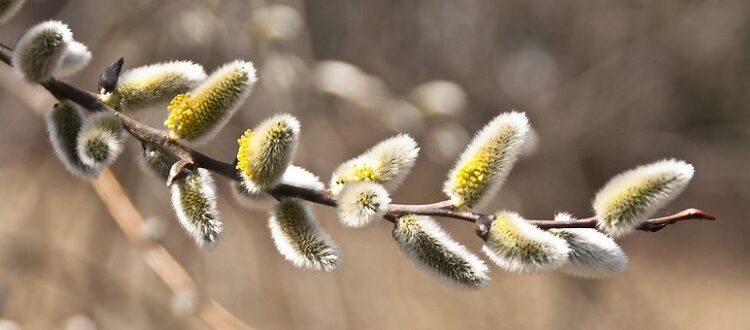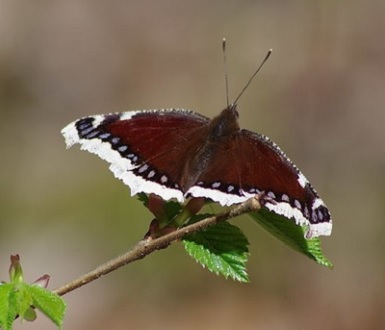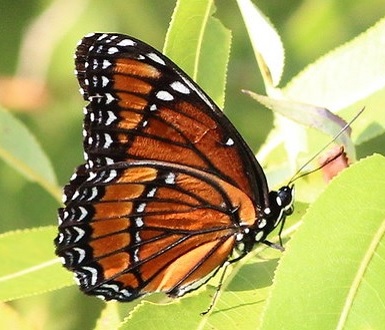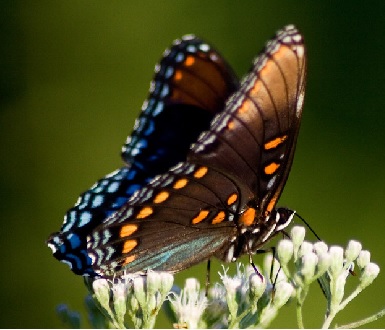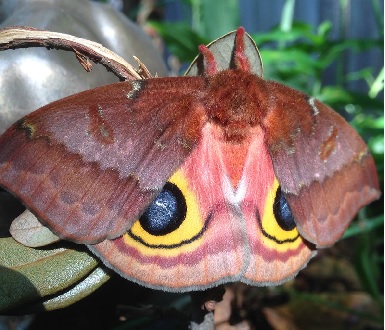FLORA FEATURE – All-Star Host for Pollinators
GET TO KNOW
American Pussy Willow
The pussy willow, with its soft and fuzzy flower catkins, is an all-star of wetland habitat plants. This fast-growing deciduous shrub provides a bountiful smorgasbord for woodland wildlife.
Deer (and other mammals) dine on pussy willow leaves and branches while squirrels relish leaves and buds.
FUN FACT on Pollination: In general, plants with showy flowers tend to rely on insect pollination while plants (many trees and grains) with inconspicuous flowers rely on wind pollination. Pussy willows, with their fuzzy, silver flowers that attract many bugs, certainly appear to be insect pollinated. However, there is substantial debate around the nature of pussy willow pollination. But, the US Forrest Service states that pussy willows take advantage of both insect and wind pollination methods to help ensure species survival.
Beavers and muskrats enjoy munching the leaves while busily building their lodges with the branches. Insects – especially many native beetles and bees – flock to the nectar and pollen offered with early blooming catkins. And where insects go, birds are soon to follow. Insect loving birds feast on the bugs, and many seed eating birds feast on the catkins and wispy seeds; while goldfinches and hummingbirds use bits of the fuzzy flower fluff to line their nests.
Perhaps best of all, for our favorite pollinators – a.k.a. the butterflies – this shrub is practically a 5-star B&B. In addition to offering some of the earliest spring nectar for pollinators (e.g.: mourning cloak butterflies and bumble bee queens), the pussy willow serves as a host plant for at as many as 14 to 18 (sources vary) different butterflies and moths. These include such beauties as the mourning cloak butterfly, viceroy butterfly (a monarch “look alike”), red-spotted purple butterfly, and the Io moth. In fact, pussy willows provide food and shelter to so many insects that the Xerces Society lists the plant as “a vital food source for hungry pollinators … a “must-have” for the pollinator garden”. (Reference: The Xerces Society is the preeminent, international organization for the conservation of insects and other invertebrates.)
PLANT SPECIFICATIONS
It should be noted that “pussy willow” is a casual term used for a variety of willow plants – both native and non-native. Therefore, it is important to correctly identify our very own native “pussy willow” by its proper name: Salix discolor (or American glaucous willow).
Salix discolor is a hardy and adaptable plant that traditionally grows along streambeds and as an understory shrub in wetland woods. Understory shrubs – those that grow underneath the high leafy canopy of a forest’s tall trees – are a vital part of woodlands because they provide much of the food / shelter for woodland animals. And, since pussy willows grow rapidly and spread easily, they are ideal for large wetland restoration projects to anchor soil, reduce erosion, and attract wildlife.
The American pussy willow is a large, multi-trunked shrub that reaches about 15 – 20 ft in height and does well in a wide range of growing conditions. It is a hardy shrub that can manage both wet, boggy soil and the occasional bit of drought. Proper pruning and maintenance can help pussy willow fit specific garden sites; and with its ability to withstand fluctuating water conditions, the pussy willow has been recognized as an ideal choice for larger rain gardens.
If purchasing a pussy willow, please be sure to shop carefully at a local native plant nursery for the true American pussy willow (Salix discolor), because imported European and Asian varieties will not serve as a host plant for North American butterflies.
Most willows, including Salix discolor, are dioecious – which means there are separate male and female plants. Only male plants produce the well-known fuzzy catkins (and pollen), while female plants produce smaller, greenish catkins and – if properly pollinated – seeds. And while many of the seeds are consumed by birds, uneaten seeds eventually “float” away on tiny silken tufts that are carried by the breeze. Also, like most willows, Salix discolor spreads, not only by seed, but also through underground rhizomes and the independent rooting of twigs. Consequently, it offers a wonderful option for colonizing large areas, but can still be reasonably maintained within garden locations.
TAKE ACTION
Healthy ecosystems include, and depend on, a rich biodiversity of native plants and animals. Unfortunately, native plants are too often overlooked in suburban landscaping efforts due to the popularity of trendy imports and flashier nursery cultivars. However, it is our native plants that create the best habitat to support our local wildlife.
FOTR works to maintain and restore our native vegetation throughout the watershed. Whether you are a property owner, city official, student, or concerned citizen, you can help FOTR spread the word about maintaining adequate natural areas of native plants for the benefit of all creatures.
See our Facebook page for upcoming educational events and volunteer opportunities where you can get outside and help us protect our Rouge River watershed. And, if you are “ready to go” for putting in your own native plant garden, please see our webpage Rain Garden Plants for more information.
MAIN PHOTO CREDIT: American Pussy willow (Salix discolor) with pollen – photo by Liz West CC-BY-2.0 – cropped

